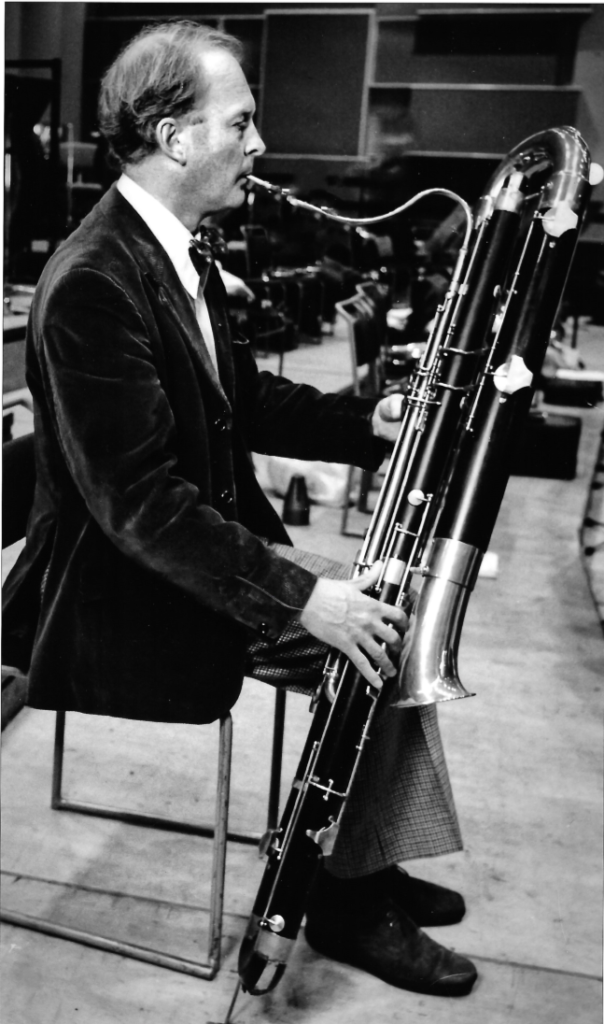
John Burness was a friendly face to so many students at the start of their College careers; always smartly dressed (often sporting a bow tie) he was keen to establish that we were all coping with the rigours of living in London before we launched into the finer points of playing the Contra.
There were no dark professional secrets with John, just good practical advice: “If you’re playing Carmina Burana there’s a very quiet and exposed movement where you are accompanying the strings – use a really soft reed, stick a duster up the bell and add a crook extension if it gets a bit sharp.” His hand-written fingering chart showed all the keys which could improve ‘problem’ notes and suggested fingerings for high notes in pieces like Mother Goose. He also taught reed-making (at a time when it wasn’t deemed particularly necessary) which involved a Sunday lunchtime trip to Chesham for a meal with his wife Pat followed by a couple of hours tuition – but of course he was just as concerned about the students’ welfare as he was about their embryonic reed-making.
John’s love of the deeper sounds of the orchestra may well have stemmed from playing the organ for Church services in his youth; he always felt that the Contra was the equivalent of the 16ft register, and in the orchestra would sometimes hold a final chord slightly longer to mimic the resonance of a deep organ pedal note. After three years of National Service in the Central Band of the RAF which enabled him to have lessons with Vernon Elliott (then in the Philharmonia and later of Ivor the Engine fame), John went on to work at Sadlers Wells, Covent Garden and the Bournemouth Symphony Orchestra where he was Principal Bassoon. Along with players like Nick Reader, John felt the Contra wasn’t taken very seriously as a musical instrument at that time (bassoonists would often ask to use a Contra even when they hadn’t really played it before), and he instilled in his students the notion that sound, intonation and musicianship were equally important on both instruments. In 1965 he joined the BBC Symphony Orchestra as Principal Contrabassoon, holding the position for 22 years alongside players that included Geoff Gambold, Bill Waterhouse, Graham Sheen and Sue Eastop.
John loved teaching at the Royal College of Music and encouraged his students to include the Contra in their final recitals: his suggestion to play a few movements of Martinu’s Suite Miniature (originally written for cello and piano) was intended simply to demonstrate to the examiner that you could play the instrument ‘in tune, musically and with a nice sound’. He was also happy to play alongside the younger generation, not only encouraging students starting to play professionally but agreeing to ‘dep’ in fledgling chamber groups such as a Bassoon Quartet playing for a wedding in deepest Gloucestershire. He would also arrange music for them, sometimes tailoring the individual parts to help a student to practice and overcome a particularly tricky rhythm. Many of his students stayed in touch after leaving College, fondly remembering their lessons and reed-making trips to Chesham, but also emulated his generous teaching philosophy themselves. I hope this recording follows in the same spirit by taking the Contra a bit more seriously and showing it can be treated as a ‘proper’ musical instrument.
Footnote John spoke about a TV commercial for Corn Flakes which he did in the 1960s and Pat remembers seeing at the time in her parents’ flat in Maida Vale. After much research Emma Neal has unearthed it: in those days bassoonists obviously practiced before breakfast! John added that picking a corn flake out of the bowl was an impromptu piece of improvisation on his part which the director loved and wanted to be kept in. You can see it here:
https://www.hatads.org.uk/catalogue/record/7c78b0b5-0da6-4e84-a90d-f459da166cdf
